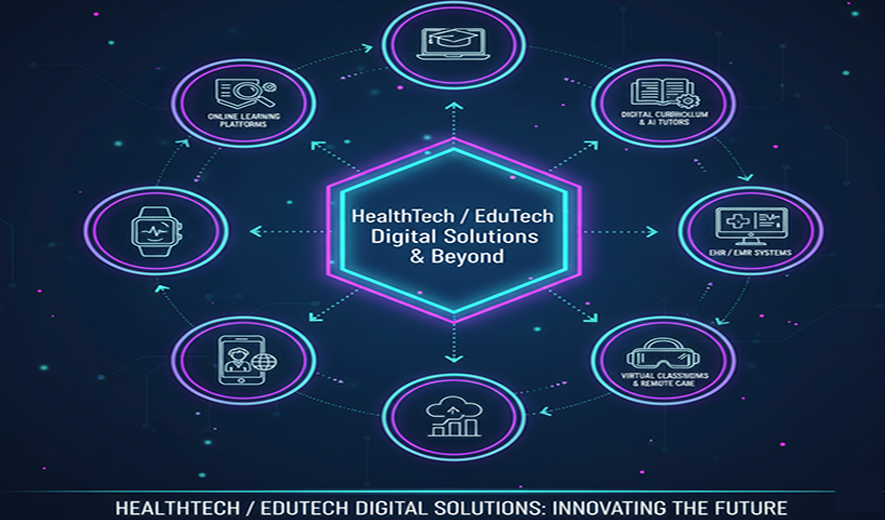
HealthTech / EduTech Digital Solutions
HealthTech and EduTech are two of the most significant and rapidly evolving sectors in the digital solutions landscape. Both leverage technology to personalize experiences, improve accessibility, and boost efficiency, fundamentally transforming the delivery of healthcare and education.
HealthTech innovations
Digital health solutions apply technology to improve medical care and wellness. From remote monitoring to advanced diagnostics, HealthTech is focused on enhancing patient outcomes, reducing inefficiencies, and lowering costs.
Key innovations:
- Telemedicine and virtual care: Platforms enable real-time video, audio, and text consultations between patients and healthcare providers, overcoming geographical barriers and increasing access to care. This is particularly impactful for patients in remote areas, those with mobility issues, and for routine or follow-up appointments.
- Remote patient monitoring (RPM): IoT-enabled devices, such as smartwatches and biosensors, track patients' vital signs and health data remotely. This allows for continuous monitoring of chronic conditions, enabling early detection of issues and timely interventions outside of traditional clinical settings.
- AI-powered diagnostics and analytics: Artificial intelligence (AI) is used to analyze vast amounts of medical data and images, assisting clinicians with more accurate and faster diagnoses. AI algorithms can predict disease outbreaks, personalize treatment plans, and optimize hospital operations.
- Digital therapeutics (DTx): DTx are evidence-based, clinically evaluated software programs that treat, manage, or prevent a broad range of medical conditions. Delivered via smartphones or tablets, they can provide therapy for mental health disorders, manage diabetes, and support physical rehabilitation.
- Electronic Health Records (EHRs): These are digital versions of a patient's medical history that streamline administrative tasks, improve care coordination, and allow for a more complete view of a patient's health across different healthcare settings.
- Biotech and genomics: Digital solutions are accelerating genomic research and drug discovery by using AI to analyze complex biological data. This leads to more personalized and effective treatments.
EduTech digital solutions
EduTech innovations utilize technology to transform learning and teaching. By using tools like AI, gamification, and cloud computing, EduTech aims to create more engaging, personalized, and accessible educational experiences.
Key innovations:
- Personalized and adaptive learning: AI-powered platforms analyze student performance in real-time, adjusting lesson content, pace, and difficulty to match individual needs and learning styles. This allows students to receive targeted support and progress at their own pace.
- Gamification and immersive learning: EdTech incorporates game dynamics, such as points, badges, leaderboards, and challenges, to increase student motivation and engagement. Immersive technologies like augmented reality (AR) and virtual reality (VR) enable virtual field trips, scientific experiments, and historical reconstructions, making learning interactive and memorable.
- Learning Management Systems (LMS): Platforms like Google Classroom and Moodle serve as centralized hubs for online courses, content delivery, and collaboration. They enable remote learning, help track student progress, and facilitate communication between students, teachers, and parents.
- E-learning content platforms: Websites and apps like Coursera, Khan Academy, and Udemy provide a vast library of online courses and educational content for all ages and subjects. This makes high-quality educational resources more widely accessible.
- Mobile learning (M-learning): With the proliferation of mobile devices, learning can now happen anywhere and anytime. Mobile learning apps offer bite-sized lessons, quizzes, and interactive content, making education more flexible and convenient for students on the go.
- Analytics and assessment: Data analytics tools track student performance and identify learning gaps, providing valuable insights for both students and educators. Automated assessment tools help streamline grading and provide immediate feedback to students.
